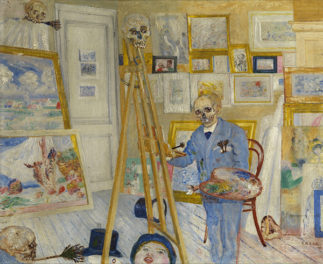
The National Museum of Cambodia. Photo: S. J. Staniski
The exhibition Gods of Angkor: Bronzes from the National Museum of Cambodia now on view at the Getty Center is a rare opportunity to experience first-hand the unique artistry of Khmer sculpture outside of Cambodia. At its height, the Khmer empire was the most powerful in southeast Asia, ruling present-day Cambodia as well as significant areas of present-day Thailand, Laos, and Vietnam.
The exhibition includes masterpieces in bronze from the collection of the National Museum of Cambodia in Phnom Penh, which is home to the largest and most important collection of Cambodian bronzes in the world.
Not many people are aware that the exhibition, which runs through August 14, also celebrates a wonderful collaboration between the National Museum of Cambodia, the Freer Gallery of Art and Arthur M. Sackler Gallery, Smithsonian Institution and the Getty as a whole.
In 2005, the Getty Foundation provided a grant enabling the Sackler Gallery and the National Museum to collaborate on a much-needed new metals conservation laboratory, to train Cambodian conservation staff, and to develop a long-term strategic plan for the conservation of its phenomenal metal collection. This Getty Foundation grant was the catalyst for the current exhibition at the Getty Center.

Conservator Hem Kannitha at work in the Metal Conservation Laboratory at the National Museum of Cambodia. Photo: S. J. Staniski
I was fortunate enough to be hired by the Freer Sackler during this time, and spent 18 months working alongside staff at the National Museum in Cambodia. It’s true that the bronze and stone images of Hindu and Buddhist divinities from this period are renowned for their beauty and technical mastery, but for me, Cambodian art also is characterized by a deep sense of mystery. This sense of mystery is what drew me in, and what colored my time in Cambodia—an urge to learn more about these truly amazing works of art.
Whether you are new to Cambodian art, or a longtime admirer, you can’t help being struck by the singularly unique Khmer aesthetic. It is like nothing else. While the lost-wax casting techniques used to create bronze sculptures during the Angkor period of Cambodia are fairly well understood from a technical viewpoint and certain stylistic schools are recognized, very little is actually known about the early origins and development of metalworking in Cambodia. Where did this artistry begin, and how did it evolve? These are questions that still need answers.
If you have the opportunity to visit the Gods of Angkor exhibition, it’s worth pausing as you enter the gallery to spend some time with the bronze bull that greets you: Nandin, the mount of the Hindu god Shiva. Dated to the 12th–13th century, this work of art, and most of the others in the exhibition, reflect the important influence of Indian culture and the central role of both Hinduism and Buddhism.

Shiva’s Bull, Nandin, Cambodian, Angkor period, 1100s–1200s. Bronze with mercury gilding. National Museum of Cambodia, Phnom Penh
This bronze bull could also be called by another name: Preah Ko, a central figure in the creation myth of the country of Cambodia. Both names are meaningful because they reflect the complex culture within which these artworks, and the Khmer identity, were shaped.
This beautiful Nandin sculpture was conserved by the staff in the newly established metal conservation lab, with my assistance and help from the head of the Department of Conservation and Scientific Research from the Freer Sackler, Paul Jett, on one of his visits to the museum. It required extensive conservation treatment to stabilize and prepare it for exhibition. Despite all we now know about this work, there is still the unknown—scholars have yet to decipher an inscription written on the base.
In contrast to the majority of bronze sculptures in the gallery from the Angkor period, which reveal a recognizable Khmer identity, the Gods of Angkor exhibition also includes a recently acquired group of seven small pre-Angkor period bronzes that date to the 7th century and earlier. The opportunity to study these early pieces, so different to the rest of the sculpture in the exhibition, may provide some insight into the obscurity surrounding the development of early Cambodia.
Gods of Angkor is a wonderful gem, a chance to experience a little bit of Cambodia’s mystery right here in Los Angeles. It’s an opportunity not to be missed.




I had the pleasure of taking my Director General of Culture and the Arts in Western Australia, Ms Allanah Lucas, on a tour of the exhibition two days after it opened and all that Sean has said is true but it is also a real lesson in understatement. The exhibition is superbly crafted, it has wonderful sensitivity to the topic and to the culture of the Khmer people and the objects are at times overwhelmingly beautiful. If you come up the hill and view the exhibition I am sure you will delighted with the brilliant craftmanship made at the height of their civilization.
Hello,
I have a few Khmer antiquities want to sell to the Museum
Can you help me communicate with each other
Looking forward to hearing from you soon
Many thanks
Chraiten
Hi Chraiten, Thanks so much for thinking of us. The Museum focuses its collection on very specific areas: Greek, Roman, and Etruscan antiquities; European paintings, drawings, sculpture, illuminated manuscripts, and decorative arts; and European and American photographs. You can find specific email addresses for each curatorial department of the Museum here. The Getty Research Institute’s special collections are primarily works on paper; an overview of the collection can be found here, along with contact information. —Annelisa / Iris editor